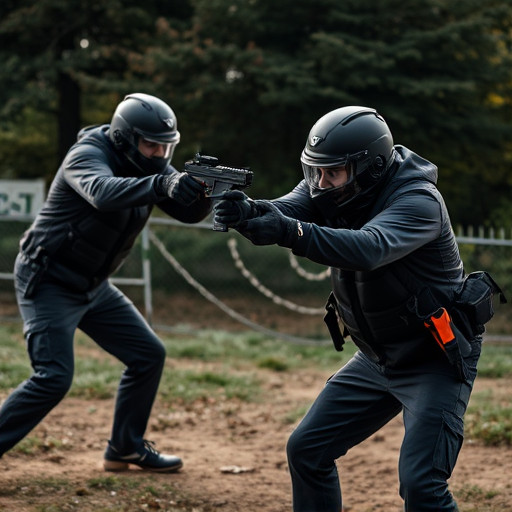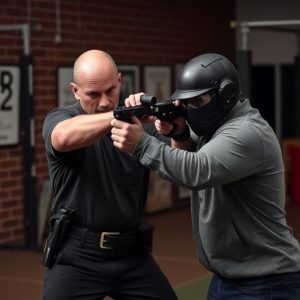Pulse Power: How Frequency Affects Stun Guns for Women’s Defense
Choosing the best self-defense stun gun for women involves understanding electrical pulse frequency…….
Choosing the best self-defense stun gun for women involves understanding electrical pulse frequency (EPF) measured in Hertz (Hz), which determines shock intensity. Higher frequencies (100,000 – 400,000 Hz) offer maximum impact without causing permanent damage by disrupting muscle control. Other crucial factors include weight/size for portability, durability/reliability, and multiple settings for versatility. Opting for the right stun gun with adjustable frequency settings ensures effectiveness, safety, and confidence in critical situations.
“Electrical pulse frequency is a critical yet often overlooked aspect of stun guns, especially when considering the best self-defense option for women. This article delves into the science behind these devices, exploring how pulse frequency influences their effectiveness. We’ll guide you through understanding electrical pulses and their impact on stun gun performance, while also highlighting factors to look out for when choosing the ideal self-defense tool tailored to women’s needs.”
- Understanding Electrical Pulse Frequency: The Science Behind Stun Guns
- Factors to Consider When Choosing a Stun Gun for Self-Defense
- Demystifying Stun Gun Output Levels and Their Effectiveness
- The Role of Pulse Frequency in Selecting the Best Self-Defense Stun Gun for Women
Understanding Electrical Pulse Frequency: The Science Behind Stun Guns

Understanding Electrical Pulse Frequency is key to comprehending how stun guns work, especially when considering them as powerful self-defense tools for women looking for effective personal safety solutions. The frequency refers to the number of electrical pulses produced per second and is measured in Hertz (Hz). Stun guns emit a high-voltage, low-current electric pulse designed to disrupt muscle control, causing the target to lose balance and strength.
A higher pulse frequency typically results in a more intense shock, but it’s not the only factor determining the stun gun’s effectiveness. The best self-defense stun gun for women should also consider other elements like voltage output, pulse width, and the overall design for ease of use and reliability in potentially stressful situations.
Factors to Consider When Choosing a Stun Gun for Self-Defense

When selecting a stun gun for self-defense, several factors come into play, especially for women seeking the best self-defense stun gun tailored to their needs. One crucial consideration is the electrical pulse frequency (EPF). Stun guns with higher EPF deliver more powerful shocks, ensuring faster incapacitation of an attacker. However, it’s essential to balance this with user comfort and control; very high frequencies can sometimes make the device harder to handle.
Additionally, weight and size are vital considerations for portability and ease of carry. Women may prefer lighter, compact models that discreetly fit in a purse or pocket. Durability and reliability are also key; look for stun guns with robust construction and a reputation for consistent performance under stress. Features like multiple settings (e.g., different voltage levels) offer versatility, allowing users to adapt to various scenarios.
Demystifying Stun Gun Output Levels and Their Effectiveness

Stun guns, often considered a best self-defense option for women, deliver electrical pulses to incapacitate an attacker. But demystifying their output levels is crucial to understanding effectiveness. Stun guns emit a series of high-voltage, low-amperage electrical discharges, typically ranging from 20,000 to 100,000 volts. This voltage is designed to override the body’s natural protective systems, causing muscles to contract involuntarily and leading to temporary paralysis or “stun.”
The effectiveness of a stun gun isn’t solely determined by voltage. It also depends on pulse width (the duration of each pulse) and current (the electrical charge flowing through the target). A well-designed stun gun delivers a powerful, concentrated pulse that can disrupt an attacker’s balance and motor functions, enabling the user to escape or seek help. When choosing a best self-defense stun gun for women, it’s important to consider these factors to ensure maximum safety and confidence in an emergency situation.
The Role of Pulse Frequency in Selecting the Best Self-Defense Stun Gun for Women

When choosing a self-defense stun gun, understanding pulse frequency is key, especially for women seeking effective protection. The best self-defense stun gun for women should deliver electrical pulses at a specific frequency to ensure maximum impact and safety. Higher frequencies, typically ranging from 100,000 to 400,000 Hertz (Hz), are often preferred as they allow for more precise targeting without causing permanent harm to the user or bystanders.
These higher pulse frequencies temporarily disrupt muscle control, leading to a loss of balance and strength in the targeted individual. This effect is crucial for self-defense scenarios where disarming or incapacitating an attacker quickly is essential. Moreover, stun guns with adjustable frequency settings offer added versatility, allowing users to tailor the device’s performance to various situations and personal comfort levels.
When selecting a stun gun, especially for self-defense purposes tailored to women’s needs, understanding pulse frequency is key. This technology plays a pivotal role in determining the device’s effectiveness and safety. The optimal electrical pulse frequency not only ensures a powerful shock but also considers user comfort and minimal risk of harm. For those seeking the best self-defense stun gun for women, choosing a model with the right pulse frequency can make all the difference in personal safety and security.


